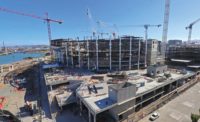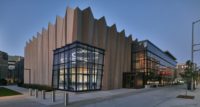Owner/Developer Holland Board of Public Works
General Contractor Barton Malow
Lead Design Firm, Structural and MEP Engineer Zachry Group
Owner’s Representative/Engineer HDR
When Holland, Mich., had to retire its aging coal-fired power plant, city officials and the community reimagined what a power plant could be. It would provide energy for the city as a state-of-the art combined-cycle natural-gas plant, but it would be set on a 26-acre park with natural wetlands and trails that link to the city. It would also feature a visitor’s center to educate on the process of making energy, and it would be attractive enough to become a gateway to an urban center known for its lakefront beaches and annual tulip festival. In the end, the 145-MW, $240-million project exceeded those goals, becoming the world’s first power generation plant to earn a verified platinum rating under the Institute for Sustainable Infrastructure’s Envision program.
When it became clear that the 60-year-old James De Young electricity plant on waterfront property would need to be replaced, Dan Nally, business services director for Holland’s public works board, led the effort to acquire 26 acres of blighted property around the proposed plant site that would serve as the home of the new plant and planned park. The property contained 26 residences, seven commercial structures and a large industrial building. It included a strip of crumbling houses near the town entrance.
About 61 land parcels, owned by a variety of entities in two jurisdictions—the City of Holland and Holland Township—were combined to make up the new site. The board completed the acquisition of all parcels without legal action and also annexed land from Holland Township under a state-enabled agreement in effect since the 1980s, according to the submitter.
An open public-comment process that involved community stakeholders generated a design that appealed to everyone—from plant workers to children set to use the visitor’s center.
HDR, the owner’s engineer, “came out with a very detailed specification, [and] we were kind of shocked,” because the board’s first priority was the aesthetics of the plant, says Peter Quist, project manager for Zachry Group, the lead design firm and structural-MEP engineer.
After consultations with the city, HDR and the public works board, the project team developed a design that was refined through stakeholder meetings about “what the building was going to look like, what function it was going to serve, and how it would interact with the community,” he says.
That connection resulted in a project that went far beyond immediate energy needs and plant design, and actually identified future economic and social benefits Holland expected from the plant. These included the park and predicted changes in community energy use over the next 40 years.
“We were actively engaged with the community in actual workshop sessions where we developed the logic and structure of the economic model to be evaluated and used,” says Dennis Bruce, principal economist at HDR. “We looked at some of the data assumptions behind what were thought to be community needs.”
Analysis of the data and community input prompted the team to extend the reach and efficiency of Holland’s existing snow melt system. Radiant heat tubes under city streets that are powered by heat generated from the new plant now cover a total of 2.5 million sq ft, thanks to more efficient controls and better operations.
HDR’s analysis also included options for plant expansion that will allow the facility to operate for at least 40 years and “impacts that were not just financial and rate-oriented,” but also had social and environmental impact, says Bruce.
According to the economist, the approach with the highest net financial, environmental and social benefit involved building a combined cycle, natural gas plant.
Achieving ISI Envision’s platinum rating required a commitment to reuse and recycle materials. Abandoned concrete slabs, wood and other construction materials littered the site when crews from general contractor Barton Malow arrived in 2014. About 9,000 tons of materials, nearly 65% of the project, were reused, and 89% of project waste was diverted from landfills. “We remediated that whole area because we dug it all out, chipped up all that old concrete and used it as base material,” says Zachry project manager Quist. “It’s really amazing, the site transformation.”
Other Envision credits were derived from equipment used in the plant. ClearSky technology was employed to abate a visible plume from the plant cooling tower. Although the plume could not be completely eliminated, it was reduced by use of a series of PVC heat exchanger modules to condense moisture within the cooling tower.
A climate analysis done by HDR climatologists studied greenhouse gas emissions and impacts to the local environment “to make sure we were earning appropriate credits there,” says Carrie Schuler, HDR project engineering manager. During construction, trees were remediated and salvageable houses were relocated, according to the submission.
J.D. McNulty, Barton Malow project manager, says Holland residents and a nearby college with 3,700 students tolerated traffic shutdowns from transport of heat recovery steam generators. “We brought the generators through town on trucks in these giant modules, with each about 100 feet long,” he says, noting they had to be set using two cranes. But, adds McNulty, residents often were “walking behind them and wanting us to do a parade.”
A craft labor shortage affected construction. Barton Malow brought on more than 20 subcontractors and 360 craft workers, with steady overtime and constantly changing schedules key to completing work.
Fixtures and other components from the old De Young plant have been incorporated into interactive exhibits at the $1.2-million visitor’s center and science museum, which has views of power plant operations. Moving the plant away from the lakefront will allow the city to redevelop that in-demand property.










Post a comment to this article
Report Abusive Comment